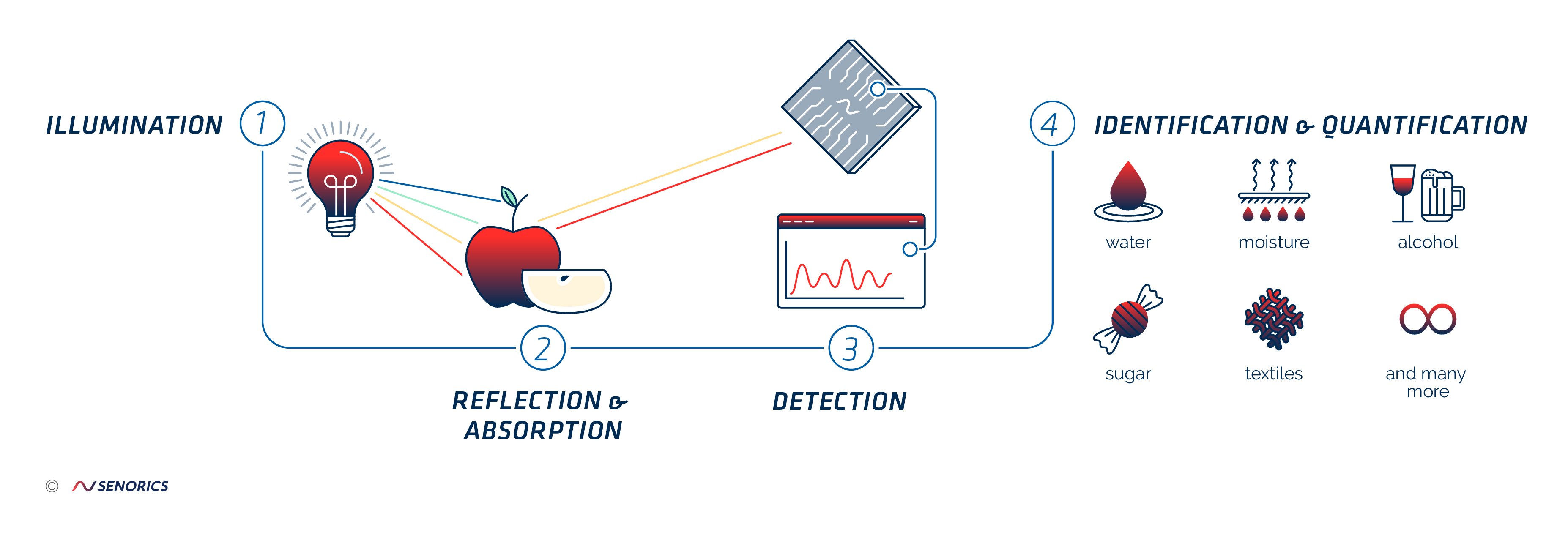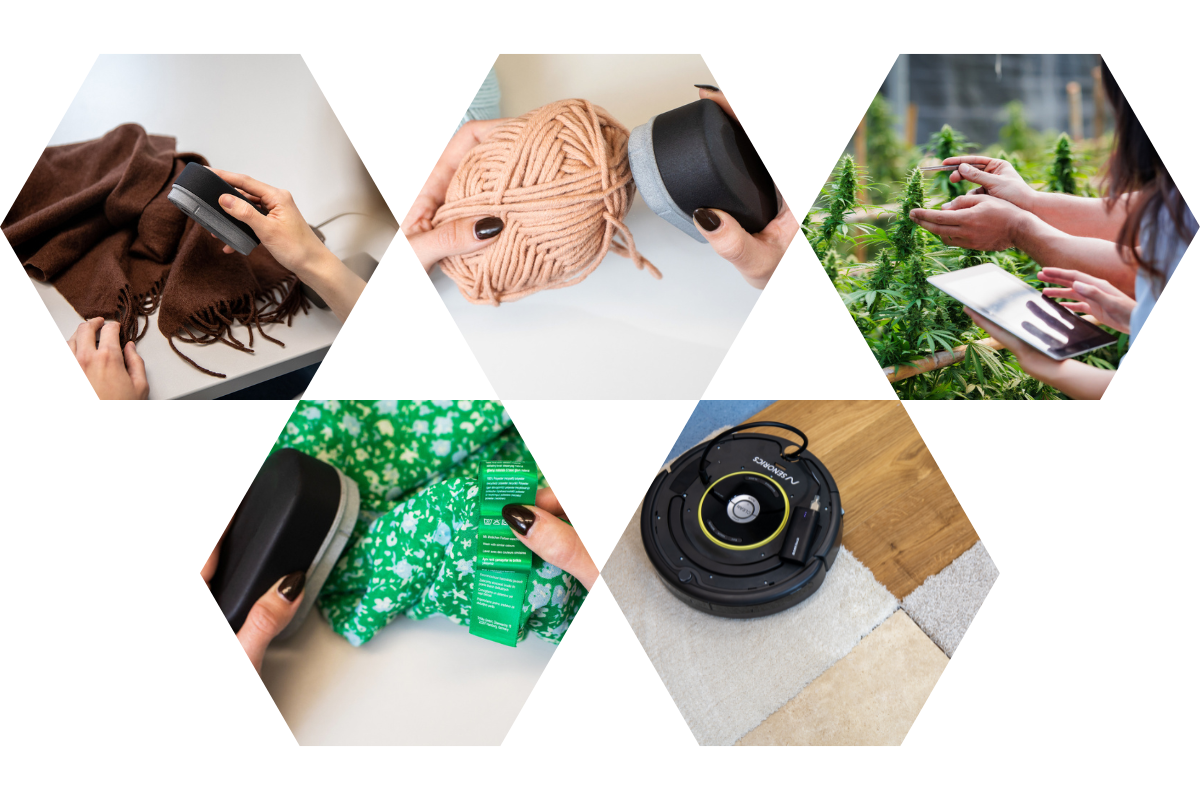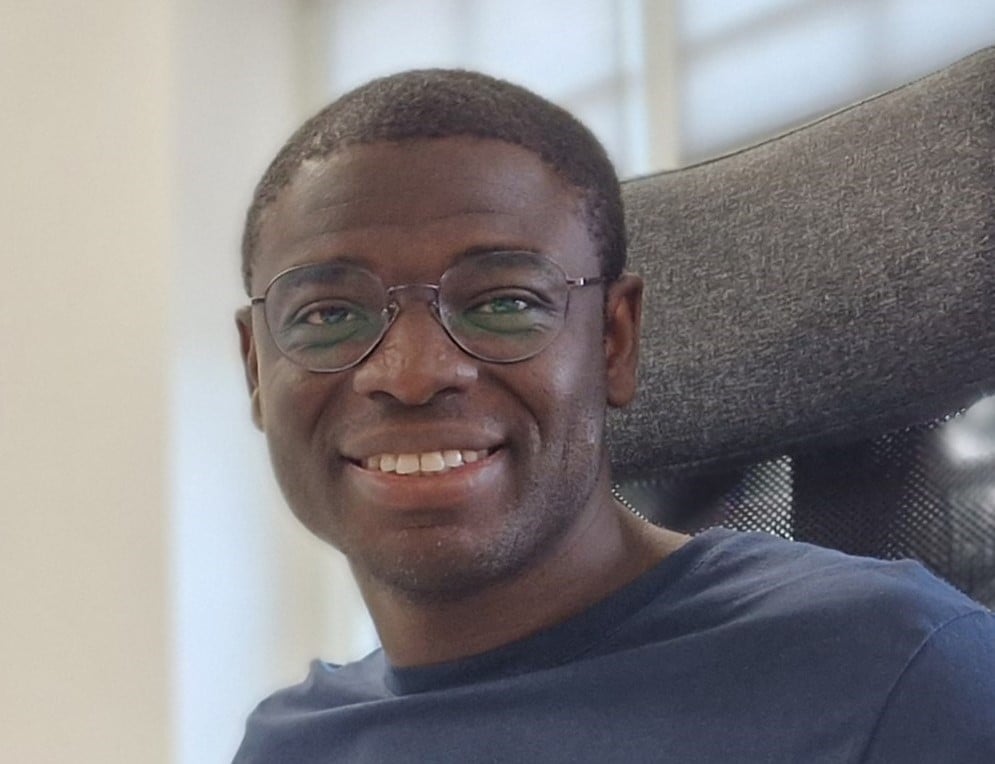Senorics’ novel sensor enables fast and easy identification and quantification of material compositions. We call this process Material Sensing, and it enables companies to analyze material quality and compositions effortlessly and within the blink of an eye. This is beneficial for a broad range of industries, for example yarn manufacturers, textile producers, and cannabis growers.
In this article we will explore in detail what are the foundations of Material Sensing, how it is conducted, and the possibilities and benefits it creates.
Based on a strong foundation: Spectroscopy and Chemometrics
Material Sensing is based on the well-established technologies NIR spectroscopy and chemometrics. By combining them on a miniaturized chip and implementing it into a handheld device, Senorics is transforming two decades-old lab technologies into a powerful mass market tool.
What is spectroscopy?
Imagine the interaction between an object and incoming light. In spectroscopy, the light created by the spectrometer is first reflected and transmitted by the object and then captured by a detection unit within the same device. This data is transferred to a corresponding software, which is where chemometrics comes into the picture.
What is chemometrics?
You can imagine chemometrics as a complex algorithm that reads and interprets inputted data and provides you with easy-to-understand results. Putting it even more simply, it translates spectroscopic data into everyday language. For this to happen, we build chemometric models that are customized to each individual use case. You can learn more about this process here.
Enabling analysis in 4 simple steps
Material Sensing is conducted in four simple steps.
Step 1: The illumination of the sample
A sample is illuminated with a light source. It is important to know that there is visible light, as well as light that cannot be seen by the naked eye, for example near infrared (NIR) light.
Step 2: The reflection and absorption of incoming light
The light is then partially absorbed, transmitted, and reflected by the object. In this process, we differentiate between transmission and reflection spectroscopy. In transmission spectroscopy, the light transmitted through the sample is detected. In reflection spectroscopy, the light that is reflected by the object is detected. Senorics’ SenoLab performs reflection spectroscopy.
Step 3: The detection of transmitted and reflected light
The reflected and transmitted light contains information about the sample’s material composition. The information gathered is also referred to as the “optical fingerprint”, unique for each material. To record the optical fingerprint, it needs to be detected and converted into a spectrum for analysis.
Step 4: The identification and quantification of materials
The recorded fingerprints are interpreted by relevant software algorithms and used to either identify or quantify the material.
 Infographic demonstrating spectroscopy
Infographic demonstrating spectroscopy
The use case possibilities are endless
Material Sensing can be of benefit to a broad range of industries and applications. Below we have gathered a few examples of what’s currently possible when using the handheld SenoLab and the SenoSense OEM module for Material Sensing.
- Textile analysis: Material Sensing enables mobile textile analysis, which simplifies and enhances incoming goods inspection, textile processing, textile recycling, and ensures that textiles are genuine and of high quality.
- Yarn analysis: Material Sensing enables yarn manufacturers to identify and quantify the composition of yarn within seconds. This is important to enable suitable processing and ensure the quality of yarns, as well as of the textiles and fabrics that will be made from it.
- Cannabis analysis: Material Sensing poses a reliable and affordable method to analyze the quality of cannabis, determine THC and CBD levels and ensure consumer safety.
- Brand protection: The application of NIR absorbers on textiles and other materials offers a new way to verify product authenticity. Material Sensing enables companies and individuals to detect NIR absorbers and differentiate between originals and counterfeits and protect their brand.
- Robotic vacuum cleaner: Material Sensing enhances the functions of robotic vacuum cleaner and make cleaning processes more thorough than ever before. Heavily dirty areas and different floor materials can be identified and treated more targeted.
If you would like to get insight into further possibilities and future applications, take a look at this blog article or at this one.
Benefits of Material Sensing conducted with the SenoLab
Now that you have learned all about Material Sensing, it is time to sum up the benefits that it offers to users...
- Material Sensing saves you a lot of time because it is fast, measurements take only a few seconds and results are available instantly
- Material Sensing conducted with Senorics’ handheld device is easy, as the hardware and software are user-friendly and require no expertise
- It is cost-effective and Senorics’ device can be purchased under a subscription scheme, leaving you in control of your spendings
- Senorics’ Material Sensing device is small and mobile, it can be used wherever you are and whenever you need it
- Finally, the results are reliable and allow you to make informed decisions
It’s time for you to decide whether you need Material Sensing to enhance and simplify your workflow. If you are still unsure, take a look at this article.




